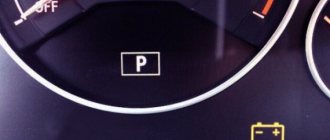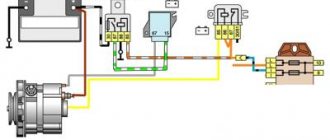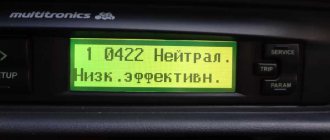The dashboard of a modern car is filled with all kinds of indicators and lights. Some of them are emergency, others are warning, others are simply service, and their operation should not cause any concern.
Among the lamps that are activated when the ignition is turned on is the battery indicator. If it doesn't light up, it's not a very good sign. There is a reason to conduct a diagnosis and determine why this is happening.
This is a typical situation that many motorists who own cars of different brands, models and ages have encountered.
The charging lamp does not light up.
If the charging lamp does not light, but other devices are working, then it may have burned out, there is a break in the excitation wire to the generator, or the generator is faulty. If all the panel devices do not work, then you should start by checking the fuse. When a lamp burns out, the generator is excited through an additional resistance, so the integrity of the lamp does not affect the operation of the charging circuit. The only exception was the first cars of the VAZ 2110 family, but this drawback was quickly eliminated, and not many such cars were produced.
A little theory
On our website we have already described in detail the structure of a car generator. Let's just say that electricity is generated in it by the rotation of the crankshaft.
As the speed increases, the voltage also increases, but it must be within the limits indicated above, otherwise the battery will be overcharged, which threatens the electrolyte boiling and sulfation of the plates.
To prevent this from happening, a relay regulator is installed in the rotor excitation circuit, thanks to which a stable voltage is supplied to the battery.
The signal from the generator to the warning lamp is transmitted through a fuse, which is also located in the generator itself. Accordingly, the light stays on until the generator starts working and transmits voltage to the battery.
The charge from the generator passes through:
- Diode;
- Regulator;
- Generator brush;
- Slip rings;
- Winding and wiring.
Thus, if at least one of these elements does not work correctly or fails, the readings of the light bulb cannot be trusted, although charging may be supplied to the battery.
Checking the generator.
To check the functionality of the generator and the charge of the battery, you need a multimeter. An inexpensive electronic device such as DT830C, M833, APPA iMeter 3 or similar is best suited for this. Pointer multimeters require precise polarity when connecting, and are very sensitive to shocks and falls. To check, just measure the voltage at the battery terminals. If the voltage is within 13.5 - 14.5 V, then the generator is working. If the voltage is less than 13.5 V, then the generator is faulty and the cause must be found and eliminated.
Wiring diagram
To diagnose and repair faults associated with the generator and excitation circuits, you need to know the operating principle of this system. Let's look at the wiring diagram of a VAZ-2114 car.
The moment the driver turns the key, the contacts in the ignition switch (5) close, and the circuit is completed. Current begins to flow from the positive terminal of the battery (1), through connectors X8 and X1 of the mounting block, through the ignition unit, fuse F16, leg 3 of connector X4, and is supplied to the vehicle dashboard (4). Through the light bulb, diode and resistor, the current flows to the common terminal connected to the negative terminal of the battery. The circuit closes and the light comes on. After a while, the engine speed increases, and the voltage from the generator through connectors X7 (leg 9 of the mounting block) and X4 (leg 18) is supplied to connector X1 (pin 12). When it reaches +12 V, the diode will close and the light will go out.
Features of the VAZ-2109 wiring diagram
The connection diagram for the VAZ-2109 generator differs from the one shown above. In it, when the key is turned in the ignition switch (11), the relay contacts (10) close. +12 V voltage from the battery (1) is supplied through intermediate elements to the indicator lamp (11) and the voltmeter (12). As the engine speed increases, the voltage increases. When it reaches the level of +12 V, the potential difference at both terminals of the indicator is equalized and it goes out.
The charging lamp does not light up, search for reasons.
What should you do if the charging lamp does not light up when you turn on the ignition? How to quickly find a problem? All subsequent actions regarding the warning lamp do not apply to the VAZ 2101 (2103, 2106).
The first step is to determine the faulty location, that is, the generator or control lamp with wire is faulty. To quickly determine, you need to disconnect the thin wire from the generator that comes from the control lamp, connect it to the vehicle ground and turn on the ignition. If the lamp lights up, then the generator is faulty. Possible malfunctions may be a break in the generator winding, a malfunction of the voltage regulator, wear of the armature brushes or slip rings, and so on.
Checking the serviceability of the lamp and wire.
If the charge control lamp does not light up, you need to check the serviceability of the lamp and wire. For this check, you do not need to remove the instrument panel and pull out the lamp to examine the integrity of the filament. It is enough to connect one probe of the multimeter, in voltmeter mode, to the disconnected wire, and the second to the car body. Instead of a multimeter, you can use a test lamp with a power of no more than 1 W.
If the circuit is working properly, the multimeter will show the battery voltage, and the control lamp will glow at half-glow. In this case, the charge control lamp burned out. If the voltmeter reading differs greatly from the battery voltage, then there may be an open circuit in the circuit from the control lamp to the generator.
Confronting attackers
Due to the fact that the battery is not cheap, the issue of protecting the VAZ 2107 battery from theft is quite acute. It’s not difficult to open the hood of a “classic,” which is why thieves are keeping a close eye on the “Sevens.”
Experts offer several options for preventing theft.
- Secure parking or secure garage.
- Alarm installation.
- Installation of the hood lock. Let’s be clear right away: few people take this step. Welding work is required, the appearance deteriorates, and it is quite easy for a professional to pick the lock.
- Take the battery with you. Labor-intensive, inconvenient, but effective. On the other hand, if the car is left for a short time, it is defenseless: they can even remove the battery in a supermarket parking lot.
- Reliable battery fixation. Almost the most popular method. The fasteners are secured with a secret that prevents dismantling and makes theft difficult. In combination with an alarm it is a very effective technique.
But all experts agree that the most reliable protection for the VAZ 2107 battery against theft is comprehensive. A combination of multidirectional measures will give the best results!
Burnt out battery indicator light
A fairly common cause of this problem is lamp failure. This is perhaps one of the simplest breakdowns, but it is not always harmless. It is advisable to replace the light bulb as quickly as possible. If there are problems with it, you will not be able to identify the problem with the generator in a timely manner. Which will lead to the battery being discharged at the most inopportune time. Thus, driving with a burnt-out lamp is highly not recommended.
Battery charge indicator light VAZ
You should also consider the design features of your car. Most generators have a built-in resistance. This allows you to generate energy even when the charge control lamp is burnt out. On some cars, the lamp itself plays the role of resistance.
This can be found on some modifications of the VAZ 2112, as well as many old foreign cars. In this case, when the light bulb burns out, the generator stops producing current. If your car has this structure, you should always have a spare lamp.
Solutions to the problem
| Reason for violation | Remedy |
| Discharged battery | Charge the battery |
| Blown fuse | Replacing an element |
| Oxidation of battery terminals | Cleaning the contacts with fine-grained sandpaper and treating with an anti-corrosion compound |
| Power cable insulation failure | Replacing the wire from the battery to the generator |
| Broken wiring in a section of the circuit | Repair the break, or replace the wire on the segment with a new one |
| Faulty contacts at the ignition coil terminals, fuse mounting in the socket, rotor leads, or indicator light | Secure the terminals, having previously cleaned them of oxides. |
| Worn mounting block relay | Relay replacement |
| Diode bridge failure | Replacing one of the diodes or the entire block |
| Failure of the generator voltage regulator relay | Relay replacement |
| ECU error | Reset the error (reboot the system by turning the ignition on and off for at least 15 seconds) |
Low battery
Another common reason why the battery warning light does not light up when the ignition is turned on in a VAZ 2106 - 2107 is a weak battery.
If, at the same time that the battery light does not light up, the dashboard instruments do not turn on or are dimly lit, then this is a clear sign of a low battery. The problem can be “cured” by simply charging the battery.
Good battery
However, not all so simple. The discharge of a car battery may not occur because the owner did not have time to charge it in time or forgot to turn off the headlights. A problem with a battery becomes dangerous if the cause lies in the generating device. As you know, the battery must be charged while the car is moving, otherwise it will discharge quite quickly. And this function falls on the generator. But if the latter is faulty, then problems arise.
What else to check
- Voltage regulator;
- Generator rectifier unit;
- Diodes;
- Generator for broken windings;
- Generator brush assembly;
- Contacts on the terminals of the generator, mounting block.
Let's continue... Diodes are checked with a test light or multimeter. If one of them is broken, the entire rectifier will have to be replaced.
To check the stator winding you need the same device. The resistance between the fasteners of the rectifier unit is measured. If there are no contacts between them, you need to replace either the winding or the entire generator.
The generator itself often fails due to wear on the brushes. To check them, you need to remove the brush assembly and measure the length of the elements. If it is 5 mm or less, the brushes must be replaced.
Almost all of the above system components are replaced when they fail, since they cannot be repaired. Only some of the generator problems can be repaired, but this can only be done by a qualified auto electrician.
The worst thing is if problems with recharging occur while on the road. Without recharging the battery, it will eventually run out completely. And even if you manage to find the cause of the breakdown and eliminate it, you will no longer be able to start the engine with the starter. It will be possible to start a VAZ-2017 with a dead battery only from a tug or pusher.
Low battery
Many have encountered a situation where the light bulb does not light up, and the devices also do not work. This is a clear sign of a dead battery. Therefore, just charge the battery. But, it is advisable to find out the cause of the discharge. It's one thing if you simply forgot to turn off the headlights. It is much worse if the reason is a non-working generator. How to do this, read the article “How to check the generator on a car without removing it.”
Be sure to carry out diagnostics and identify the cause. Otherwise, you will get this problem regularly. Do not forget that a complete discharge of the battery leads to accelerated wear of the plates.
Conclusion
. There are many different indicators on the dashboard, one of the important ones showing the operation of the generator. At the same time, for various reasons it may fail, and then people wonder why the battery light does not light up when the ignition is turned on. The reason for this is the circuits and devices associated with this lamp. To fix the problem you will have to check all these elements. You cannot delay this work, as this can lead to unpleasant consequences.
Fuse
A failed dashboard light may be caused by a blown fuse. In this case, several devices usually fail at once. If such a symptom appears, you just need to check the fuse. It is located in the mounting block. You can find it using the diagram on the block cover. To check, the fuse is removed from the mounting block.
The easiest way is to install a known good fuse. If this is the reason, then the light should light up when the ignition is turned on. You can also check the fuse by measuring the resistance with a multimeter.
The whole process is described in detail in the article “How to check a fuse in a car with a multimeter.”
Diagnostics
The search for a faulty element begins with checking the battery charge level. To measure the voltage at the terminals, use a multimeter or voltmeter. It is necessary to take readings in two modes:
- without load with the ignition turned off and the minus terminal removed;
- under load: by turning the key in the ignition and turning on any consumer (low beam headlights, air conditioning).
The multimeter probes in voltmeter mode are connected in series: the positive terminal is a red contact, the negative terminal is a black one. The normal value of the battery voltage at rest with a 100% charge is 12.05 - 12.6 Volts.
Important!
The battery voltage directly depends on the state of charge: if the level is reduced to 10%, then the maximum voltage without load at the terminals will be about 11.3 Volts.
The test under load should be carried out carefully, observing safety precautions: when turning on the ignition, do not touch the power terminal and cable with your bare hands. The multimeter readings are taken twice: when the engine starts, and after 20-30 seconds. When starting the engine, the power current can reach a peak of up to 670 Amps, depending on the power of the unit. The battery supplies a significant part of the energy to the starter for the initial crankshaft rotation - at this moment the voltage at the terminals drops. A value of 8-9 V is considered normal; if the drop during startup is critical and reaches 6 V, then the battery is completely faulty.
Circuit fault
The reason the light bulb does not light may be a problem with the circuit powering it. There are several nuances here:
- Problems with contacts
. Quite a common problem. Usually appears after winter. During the cold season, moisture accumulates on the connectors, which causes the formation of oxides. The contact becomes significantly worse, as a result, the light bulb stops working. Typically, this problem manifests itself extremely unstable. One time it doesn't light up, the next time it works as usual. Clean all connectors and treat them with grease intended for this purpose; - Open circuit
. To identify the problem, you need to check the circuit using a multimeter. Perhaps there was a break somewhere. Find the faulty area and replace it; - Relay problem
. Some car models have a relay that controls the battery charge light on the panel. If this relay fails, the lamp will not light up. To check, use a multimeter to measure the voltage at the positive terminal of the relay. If there is a problem with the generator, the voltage will be less than 6 V; if the voltage is higher, the relay is faulty. It needs to be replaced. In detail about this, we wrote an article “How to check the generator regulator relay?”.
How to reset the “low battery” error
The best advice is to take the car to a service station. There, experienced specialists will do everything safely, quickly, without compromising the delicate electronics of the engine control systems and the safety of the machine. In some foreign car models, this problem disappears over time (if all elements of the charging system are functioning normally). You can solve the problem yourself. To do this, you need to disconnect the negative terminal for three minutes, and then put it back in its place and tighten it well.
You need to know that the battery charging indicator light, by its lighting, blinking and other abnormal glow, signals simple malfunctions. For example, failure of a separate diode, malfunction of the relay regulator, loosening of the drive belt. If a light bulb is detected, it is imperative to find and correct the reason for the lack of battery charge. Or you may soon need to buy a new generator or battery.
Video: the generator does not charge, how to find the fault and achieve proper operation
Unexpected malfunctions in the vehicle's on-board electrical network can lead to serious consequences. It is necessary to respond extremely quickly to the glowing signals of the control system self-diagnosis indicator lights, including the lit battery charging indicator. At the diagnostic station, using the error code, they will quickly identify and correct any malfunction in the charging system of the DC source.
FakeHeader
Comments 15
I have the same bullshit with the business tidy, and when I set it to business, there is no charging when it’s cold until you rev it up to 1200, but when it’s hot it immediately appears. I put the tidy up to my business, there is no such problem... Even if it’s hot or cold, the charge goes straight away.
The generator is excited through the lamp. Look at the wiring (lamp circuit) from the dash to the generator. There is a break/poor contact somewhere. There may be a malfunction in the transition connector from the passenger compartment to the engine compartment; this is a common problem with them.
Can you tell me where this adapter connector is?
Connection of underhood and interior wiring. I came across a gazelle with connectors directly on the engine shield (round).
In the fall I installed new ones with a 3-level regulator
I see the tidy is old and I’m talking about business, sorry, I didn’t understand. Clean out all the masses, pluses, everything up to the genes and before in the box near the battery.
Sorry guys, I don’t have a bulletin board for this, but the problem is tidying up the gazelle business. There you need to solder the resistance and everything will be good. This problem is written down on the drive + photos where to show it.
So I don’t have a business, I’m just a non-entity
Sorry guys, I don’t have a bulletin board for this, but the problem is tidying up the gazelle business. There you need to solder the resistance and everything will be good. This problem is written down on the drive + photos where to show it.
And I’m looking))) Resistance is quite possible. But, I have voltage at the excitation terminal, 11.5 volts.











